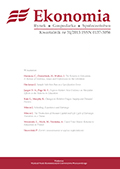Introdukcja euro w perspektywie akcesji i wyzwań absorpcji
The introduction of the euro in the perspective of accession and the challenges of absorption
Author(s): Katarzyna Dąbrowska-Gruszczyńska, Marcin GruszczyńskiSubject(s): Economy
Published by: Uniwersytet Warszawski - Wydział Nauk Ekonomicznych
Summary/Abstract: The introduction of the euro is one of the elements of wider strategy of EU integration. After the accession the new member countries tested significant and rapid inflow of portfolio and direct investments. This Inflow—paradoxically— may make it difficult to introduce a common currency. It is additionally strengthened by the ineffectiveness of the exchange rate mechanism. This ineffectiveness may cause that the rate of exchange can be recognized as guaranteed, taking the currency risk off the market participants who invest in the assets denominated in the currencies of the new member countries or raise a credit in the foreign currency. This causes—short and long term—inflow of the investments, and at the same time bigger pressure of appreciation of these currencies. The effect of the inflow, except the real and the nominal appreciation, is additional inflationary pressure. The thesis advanced by the authors is that, after the asset there is a change of efficiency of the rate of the exchange in Poland, Czech Republic and Hungary. The weekly courses such as EUR/PLN, EUR/CZK, EUR/HUF were examined. The correlations of delays were tested and the Ljunga-Boxa autocorrelation (Q) as well.
Journal: Ekonomia. Rynek, Gospodarka, Społeczeństwo
- Issue Year: 2009
- Issue No: 22
- Page Range: 56-74
- Page Count: 20
- Language: Polish

